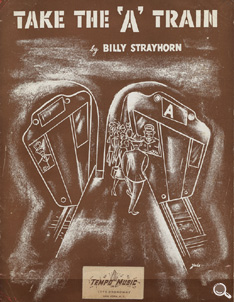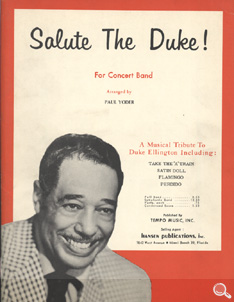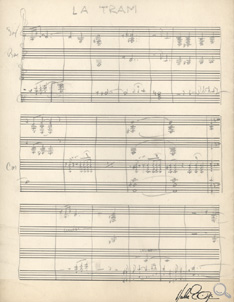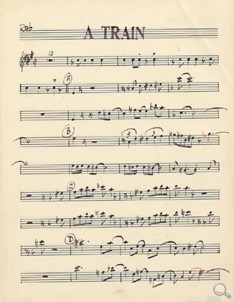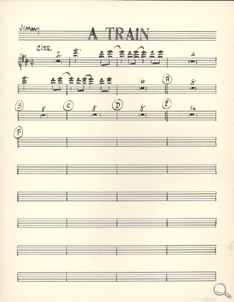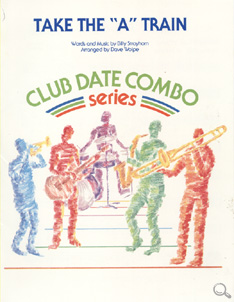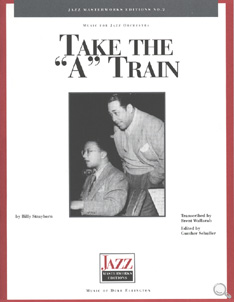

Take the "A" Train
Duke's son Mercer Ellington recalled that he found Take the "A" Train in a garbage can after Strayhorn discarded it because it sounded too much like a Fletcher Henderson arrangement.
Take the "A" Train, cover detail. The original sheet-music edition of Take the "A" Train was published by Tempo Music, the company Ellington established to control his musical copyrights. It shows a New York City subway train marked "A." Sam DeVincent Collection of American Sheet Music, National Museum of American History Archives Center.
In the time-honored jazz tradition, Strayhorn built "A" Train on the harmonies of an earlier piece, Jimmy McHugh's Exactly Like You (1930), but camouflaged the source well. Strayhorn's driving composition and uncluttered arrangement bear many Ellingtonian hallmarks, such as the use of mutes by the trumpets and trombones; the sound of the sax section; effective use of contrast (for example, between muted and open trumpet, and between the trumpet solo and the saxophone section; and, in the diminuendo ending, careful attention to dynamics.
Take the "A" Train marked Strayhorn's breakthrough as a composer. This compelling dance number became a hit recording, and Ellington made it his orchestra's signature tune from 1941 until the end of his life. Willis Conover adopted it as the theme song for his long-running jazz program on the Voice of America, the shortwave radio service of the U.S. government. The piece was used in the 1961 film Paris Blues. It has been widely recorded, by musicians ranging from Cab Calloway, Lawrence Welk, and Henry Mancini to Phyllis Hyman and Bobby McFerrin. In 2000, National Public Radio selected "A" Train as one of the "NPR 100"—the hundred greatest songs of the 20th century.
The Lyrics
Strayhorn said he was writing subway directions, as there was a new subway line and people were getting confused about the best way to get to Harlem. "Sugar Hill" was an upscale area of Harlem in which Ellington made his home. There are various versions of the lyrics to this piece, and singers have often taken liberties with the words. Here is one standard version.
You must take the A Train
To go to Sugar Hill way up in Harlem.
If you miss the A Train,
You’ll find you’ve missed the quickest way to Harlem.
Hurry, get on, now it's coming
Listen to those rails a-thrumming.
All aboard! Get on the A Train.
Soon you will be on Sugar Hill in Harlem.
Take the "A" Train Sheet Music, undated
This arrangement was part of a medley for concert band.
Take the "A" Train Sheet Music, undatedSam DeVincent Collection of American Sheet Music, National Museum of American History Archives Center.
Take the "A" Train Sheet Music, 1952
Ellington and Strayhorn sometimes playfully gave their manuscripts pseudonyms as titles; here La Tram stands for Take the "A" Train. This score is from a re-orchestration of "A" Train for a 1952 recording date that featured singer Betty Roche and saxophonist Paul Gonsalves. This is the beginning of the seventh chorus.
Take the "A" Train Sheet Music, 1952. Ruth Ellington Collection, National Museum of American History Archives Center.
Take the "A" Train Sheet Music, 1957
Billy Strayhorn arranged these parts for saxophonist Johnny Hodges ("Rab" or "Rabbit") and Jimmy Hamilton (clarinet) for Take the "A" Train, for the 1957 recording Ella Fitzgerald Sings the Duke Ellington Song Book, in which she was accompanied by the Duke Ellington Orchestra.
Take the "A" Train Sheet Music, 1957. Duke Ellington Collection, National Museum of American History Archives Center.
Take the "A" Train Sheet Music, 1957. Duke Ellington Collection, National Museum of American History Archives Center.
Take the "A" Train Sheet Music, 1960s
This arrangement was made for a small combo.
Take the "A" Train Sheet Music, 1960s. Ruth Ellington Collection, National Museum of American History Archives Center.
Take the "A" Train Sheet Music, 1960s
This piano-vocal edition of Take the "A" Train was issued in the 1960s. While Ellington is not mentioned on the cover, he is prominently pictured.
Take the "A" Train Sheet Music, 1960s. Sam DeVincent Collection of American Sheet Music, National Museum of American History Archives Center.
Take the "A" Train Score, 1993
The Smithsonian published this edition of Take the "A" Train in 1993. At that time, the original manuscript was not available to scholars, so the piece was transcribed note-fornote from the original 1941 recording. For the benefit of musicians and scholars, this edition includes parts for each of the instruments, a conductor's score, and an essay by the noted composer and conductor Gunther Schuller.
